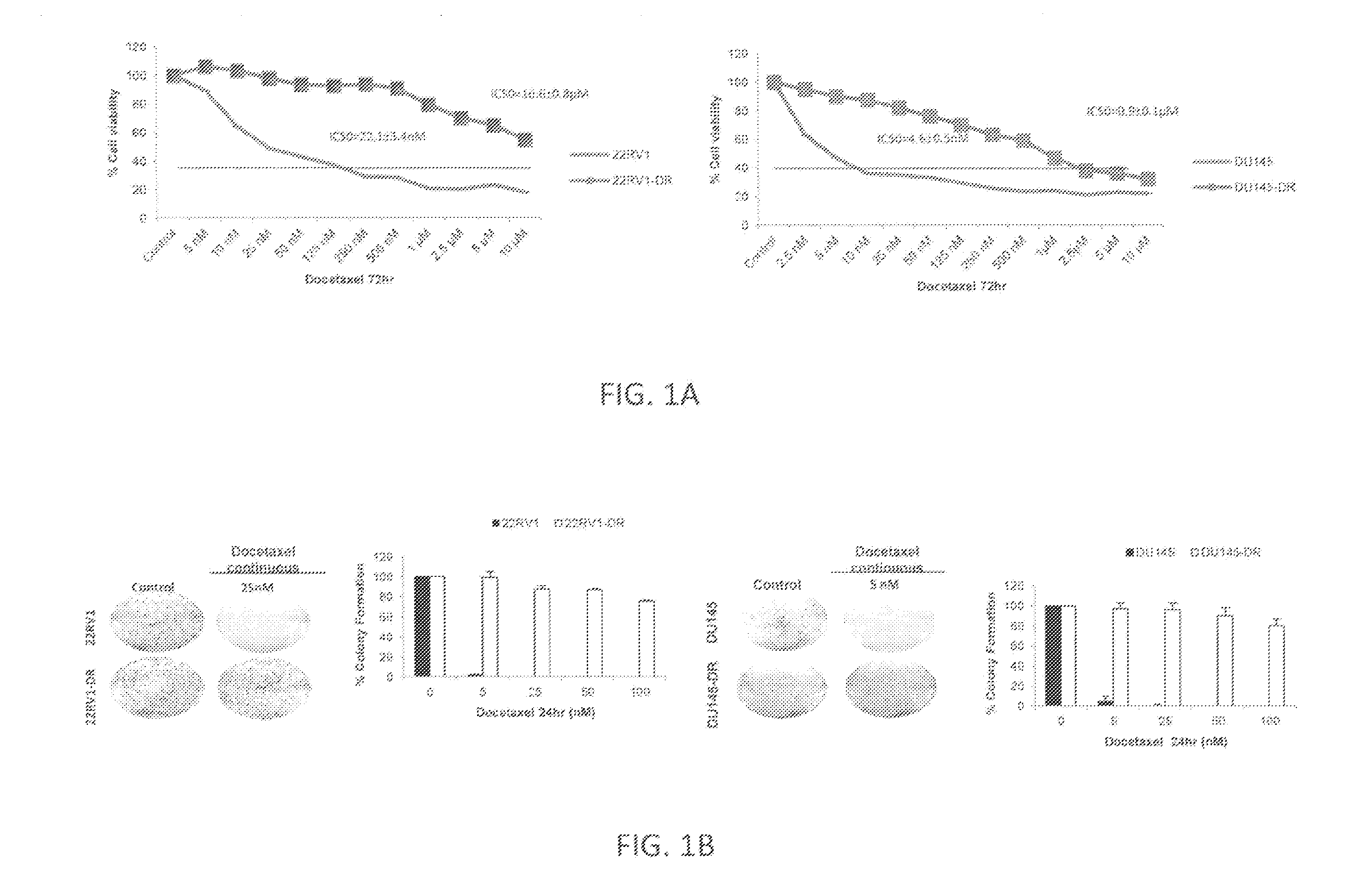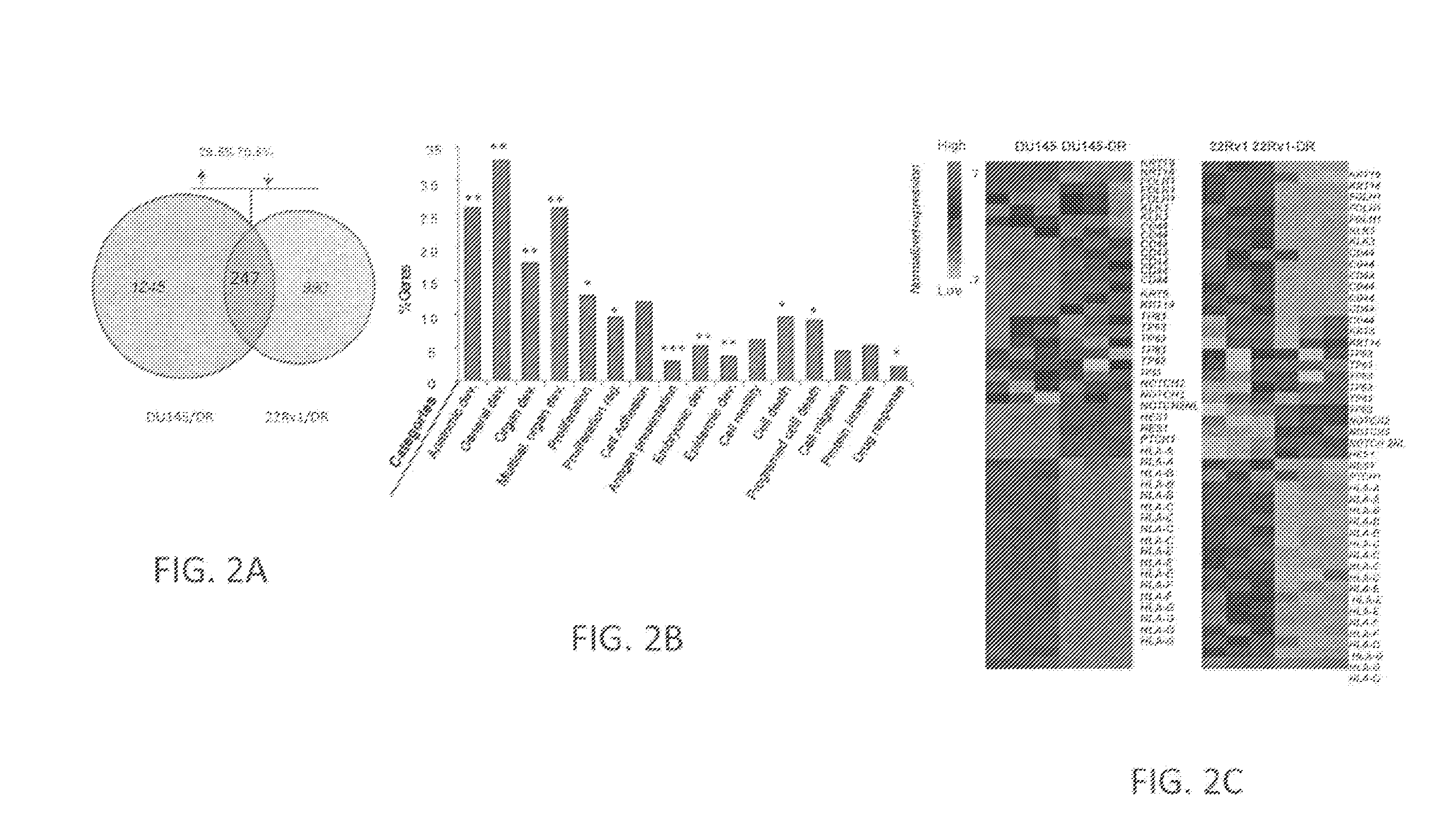Targeting chemotherapy agent resistance in cancer
a technology of chemotherapy agent and resistance, applied in the field of cancer chemotherapy agent resistance, can solve the problems of many patients relapse, cancer often progresses to a hormone refractory state, and the acquisition of chemotherapy resistance is devastating and widespread, and achieves the effect of increasing the expression of gli1
- Summary
- Abstract
- Description
- Claims
- Application Information
AI Technical Summary
Benefits of technology
Problems solved by technology
Method used
Image
Examples
example 1
General Methods
[0077]Generation of Acquired Docetaxel Resistant Prostate Cancer Cell Models.
[0078]Human HRPC cell lines, DU-145 and 22RV1, were obtained from American Type Culture Collection (ATCC) and maintained in RPMI 1640 medium (Gibco) supplemented with 10% FBS without antibiotics. Docetaxel resistant clones, DU-145-DR and 22RV1-DR, were selected by culturing cells with Docetaxel in a dose-escalation manner using 72 hr exposures. Initial culture was at 5 nM Docetaxel for DU145 and 25 nM for 22RV1. After sensitive clones were no longer present and surviving DU-145 and 22RV1 cells repopulated the flask, the concentration of Docetaxel was increased to 10 nM, 25 nM, 50 nM, 100 nM and 250 nM. 22RV1-DR cells were further exposed to 500 nM Docetaxel. The process of acquired drug resistance took 9 months for DU-145-DR and 6.5 months for 22RV1-DR. In parallel, parental DU-145 and 22RV1 cells were exposed to DMSO (vehicle solution) in the same dose-escalation manner.
[0079]Human Prostate ...
example 2
Docetaxel Resistant Prostate Cancer Cells Lack Differentiation Markers and Show Upregulation of the Notch and Hedgehog Signaling Pathways
[0133]To study the phenomenon of relapse following Docetaxel therapy, chemoresistance models were generated in vitro using the well established HRPC cell lines, DU145 and 22Rv1. Drug resistant cells were established by exposure to increasing concentrations of Docetaxel, and resistance was validated by cell viability (FIG. 1A), colony formation (FIG. 1B), Annexin V (FIG. 1C), and poly-(ADP-ribose) polymerase (PARP) cleavage assays (FIG. 1D). Gene expression profiling using oligonucleotide microarrays was performed to compare the sensitive parental cells (DU145 / 22Rv1) with the Docetaxel resistant cells (DU145-DR / 22Rv1-DR). This analysis revealed 1245 deregulated genes in DU145-DR cells and 990 deregulated genes in 22Rv1-DR cells, of which 247 overlapped (FIG. 2A). Of these overlapping genes, 29.5% were consistently upregulated and 70.5% were consiste...
example 3
Primary and Metastatic Prostate Cancer Tissues Contain Cells that Display the Docetaxel Resistance Phenotype and Associate with Tumor Aggressiveness
[0136]Experiments were conducted to determine whether cells with the identified Docetaxel resistant phenotype were detectable in human prostate cancer tissue samples. Analysis was carried out on paraffin embedded tissues from 31 untreated primary prostate tumors from patients who had undergone radical prostatectomy and 36 metastatic prostate cancer tissue samples from untreated or Docetaxel treated patients. Immunofluorescence-based double staining revealed that all prostate cancer tumors had a small subpopulation of CK-negative tumor cells that displayed the Docetaxel resistant phenotype observed in the in vitro models described in Example 2. CK18 and CK19-negative cells were mainly HLA class I-negative (98.5±1.1%) and displayed nuclear expression of cleaved Notch2 (72.8±15.1%), Gli1 (67.5±17.3%), and Gli2 (67±17.3%), whereas CK-positiv...
PUM
| Property | Measurement | Unit |
|---|---|---|
| Electrical resistance | aaaaa | aaaaa |
| Time | aaaaa | aaaaa |
Abstract
Description
Claims
Application Information
 Login to View More
Login to View More - R&D
- Intellectual Property
- Life Sciences
- Materials
- Tech Scout
- Unparalleled Data Quality
- Higher Quality Content
- 60% Fewer Hallucinations
Browse by: Latest US Patents, China's latest patents, Technical Efficacy Thesaurus, Application Domain, Technology Topic, Popular Technical Reports.
© 2025 PatSnap. All rights reserved.Legal|Privacy policy|Modern Slavery Act Transparency Statement|Sitemap|About US| Contact US: help@patsnap.com



